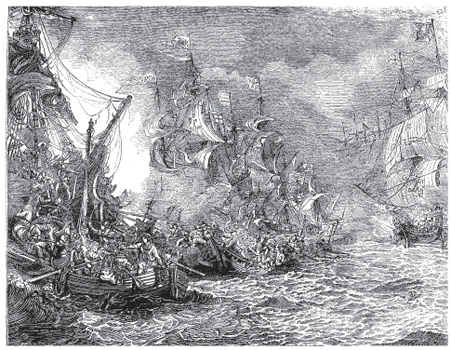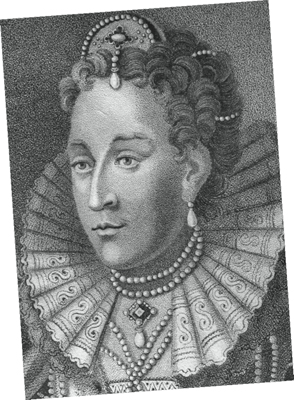Plymouth (7 page)
Authors: Laura Quigley

Drake soon found himself under attack from the Spanish and unable to travel north or south, so, in a desperate effort to return home, he steered the
Golden Hind
westward and faced a brutal journey across the Pacific, finally returning to Plymouth in 1580, laden with treasure and stories of adventures in the Spice Islands, as the first Englishman to circumnavigate the globe.
Drake’s finest hour, however, came with the defeat of the Spanish Armada. In 1587 Queen Elizabeth I was suspicious that the King of Spain was intending to invade England and she sent Drake to engage the Spanish fleet in a pre-emptive strike. Taking four of her largest battleships, Drake burned King Philip’s fleet while they were still moored in Cadiz Harbour. On his way home, Drake managed to take the Spanish merchant ship
San Filipe
– which had £1 million in treasure on board.
In revenge, King Philip of Spain created the most powerful armada of ships Europe had ever seen, and – mustering 55,000 men for the fight – prepared to invade England. However, luck was not with the Spanish. Its first commander, the Marquis of Santa Cruz, died in February 1588, and was replaced by Medina-Sidonia who, though high-ranking, had no experience of the sea. Their army was reduced by disease to 16,000 and many of the men were ill-equipped. The fleet was then delayed by bad weather, with five of its major ships forced to leave the fleet before they’d even sighted the English coast.
The English fleet mustered in defence, a rag-tag mix of Navy ships and privateers, was greater in number – 200 ships to 130 of the Spanish – but the Spanish firepower was twice that of the English. The key to the success of the English fleet came from Hawkins’ brilliance as a shipwright, designing smaller ‘race-built’ ships, highly manoeuvrable in the midst of battle. The English fleet waited in Plymouth Sound for news of the Spaniards’ approach.
On 19 July 1588 Drake and his captains were playing bowls on the Hoe when Captain Thomas Fleming, a fellow privateer, brought his merchant ship into the Sound and rushed over to the party to announce he had sighted the Spanish Armada approaching. Drake is famous for calmly declaring before the breathless Fleming that they still had time to finish their game – but of course they could not make sail if the wind and tides were against them.
![]()
If the sightings are true, Sir Francis Drake still haunts Boringdon Hall, originally one of the Saxon manors in Plympton that changed hands when the Normans invaded. It was a popular residence for the Elizabethan heroes, and Queen Elizabeth I herself once stayed there while visiting the West Country. Sir Francis appears in the Great Hall at Boringdon, in his full armour, his sword at the ready.
![]()
When the English finally engaged with the Spanish, it was at daybreak on 21 July 1588, just off the Eddystone Rocks, a treacherous reef 10 miles south of the Rame peninsula. The English had the wind in their favour, and their small ships quickly avoided the Spanish attacks. Drake captured much-needed gunpowder from the Spanish ships, but his tactics left the English fleet in disarray, and it took a day for them to regroup and catch up to the Spanish, who were by then making their way along the English coast to Portland.
![]()
The Ship Inn in Exeter famously barred Sir Francis Drake because of his drunken behaviour, but this hasn’t stopped him coming back to haunt the current owners…
![]()
An attack at the Isle of Wight sent the Armada fleeing to Calais, where the English attacked again, with eight fire-ships, warships filled with pitch, brimstone, gunpowder and tar and set alight, cast downwind in the direction of the Armada. Medinia-Sidonia’s flagship held its ground, bravely facing these floating fire-bombs, but the rest of the fleet scattered in confusion.
Sidonia then regrouped his fleet near Gravelines in the Spanish Netherlands, but Drake had learned a few of their tactics, realising that the gunners were instructed to fire just once and then head for the rigging to make ready for boarding the enemy ships. The quick English ships provoked the Spanish into firing but managed to stay out of range, and concentrated their own fire on damaging the Spanish ships below the water-line. After eight hours of continuous fighting, the English, running out of ammunition, were forced to use anything at hand to load the cannons. By late afternoon, the English were forced to pull back. But the damage to the Spanish ships was extensive, with two galleons run aground and the Spanish exhausted: the battle was finally over.
The threat of invasion was still present, however, and on 8 August 1588 Queen Elizabeth I gave probably her most famous speech in Tilbury, amidst a force making ready to defend London:
I know I have the body of a weak and feeble woman; but I have the heart and stomach of a king – and of a King of England too, and think foul scorn that Parma or Spain, or any prince of Europe, should dare to invade the borders of my realm, to which, rather than any dishonour should grow by me, I myself will take up arms – I myself will be your general, judge and rewarder of every one of your virtues in the field...
Of all the privateers, Drake was Elizabeth’s favourite. He brought her wealth, success and popularity few Kings or Queens of England would ever attain.

The English grapple with the Spanish Armada, firing anything to hand.

Elizabeth I as a young woman.
1580
A COFFIN AND TWO JUDGES
J
UDGE JOHN GLANVILLE
(1542-1600) – whose effigy at Tavistock lost part of its nose during the Civil War – was famous in Plymouth for ruthless judgements administered without favour or bias – even going so far as to have his own daughter executed for murder, or so the story goes.
His daughter, Elizabeth Glanville, fell in love with a Naval Lieutenant called George Stanwich, but her father disapproved and forced her to marry a Plymouth goldsmith called Sir John Page – sometimes known as ‘old Page’ or ‘wealthy Page’ – who was considered by many to be a miser. Page lived in a house on Woolster Street which subsequently became Mayoralty House, and here the miser met his death. (The house no longer exists, subsumed under the extension of the Guildhall when it was rebuilt after the bombings of the Second World War.) It seems that Elizabeth, with the help of her maid and her lover, murdered her bridegroom-to-be, either shortly before or after the marriage. A neighbour reported overhearing a man in the street softly calling up to the Page house: ‘For God’s sake, hold your hand!’
A female voice replied from within: ‘Tis too late: the deed is done.’
![]()
ANOTHER MURDER!: In 1874 one Sylvanus Sweet smashed in his wife’s head with a cutlass. As she lay dying, he got a cab to the police station and gave himself up, admitting he’d murdered her because she was trying to have him sent to a lunatic asylum. It emerged that he suffered frequently from epileptic fits and there was a history of madness in the family. His wife had left him a year before as they discussed divorce proceedings, but she had recently returned to give him one last chance. It was indeed to be one last chance. And Sweet was found guilty but insane.
![]()